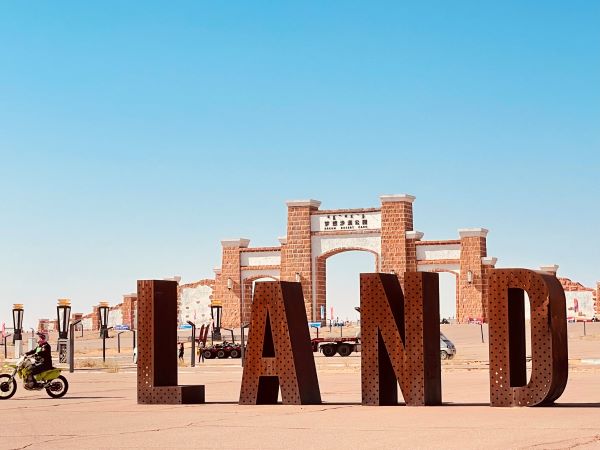Alshaa Left Banner: A profile and history
- Updated: 2024-03-01
Alshaa Left Banner is one of the 19 border banners of ethnic groups in Inner Mongolia autonomous region. It covers a total area of 80,412 square kilometers, accounting for 30 percent of the total area of the whole league.
Alshaa Left Banner has jurisdiction over 11 Sumu towns, four streets and 114 Gazha villages. It includes 35 ethnic groups including Mongolian, Han, Hui, Manchu and Daur. It has a total population of 176,000. The Han population of 128,000 accounts for 72.8 percent, and the Mongolian population of 36,700, accounts for 20.79 percent. The population of other ethnic groups is 11,300, equivalent to 6.41 percent.
Alshaa Left Banner borders Ningxia in the east, Gansu in the west and south, and Mongolia in the north, with a border line of 188.7 kilometers. In 2016, Wuliji Port was approved by the State Council for construction and then temporarily opened in 2020. Various infrastructure constructions are progressing in an orderly manner.
Alshaa Left Banner is the hometown of Awang Dandel, a famous scholar of Mongolian, Tibetan and ancient Sanskrit and a Buddhist. It is also the place where the sixth Dalai Lama Tsangyang Gyatso (1683 - c.1706) died, and one of the most well-preserved areas of Mongolian traditional etiquette in the world.
In April 1961, Alshaa Banner was divided into Left Banner and Right Banner. In 1969, Alshaa Left Banner was put under the jurisdiction of Ningxia. In 1979, it was re-placed under the jurisdiction of Inner Mongolia autonomous region. On May 1, 1980, the Administrative Office of Alshaa League was formally established.
The ecological environment is fragile in the area. The average annual rainfall is 80-220 mm and evaporation is 2,900-3,300 mm. Two deserts including Tengger and Ulan Buh run through the whole territory, and the desert sand area accounts for two-thirds of the total area of the whole Banner. There are more than 83 million mu (5.53 hectares) of natural grassland and more than 570,000 mu of cultivated land (with a total sowing area of more than 280,000 mu).
There are historical sites that include the following: Dingyuanying Ancient City, Alshaa Heshuote's Royal Residence, eight temple monuments including Guangzong Temple and Fuyin Temple, natural landscapes including Helan Mountain Primeval Forest, Tengger Desert and Ulan Buh Desert, and Aolun Prague Grand Canyon featuring Yadan and Danxia landforms.
Alshaa Left Banner boasts rich natural resources. It has abundant sandy plants such as Cistanche deserticola and Cynomorium songaricum. Their annual output is 1,500 tons and 600 tons, respectively. The livestock population includes 46,000 Alshaa bactrian camels and 304,000 white cashmere goats, which are local excellent breeds. The total installed capacity of wind and solar power generation reaches 755,000 kilowatts, and the 1.6 million kilowatts wind power project in Aolun Prague Town. The supporting Haoya 500 kV power transmission and transformation project are under construction, with solar energy resources reserves of about 210 million kilowatts.
A total of 57 kinds of minerals have been discovered, of which the proven reserves of coal mines are 930 million tons, gold mines are 3.56 million tons (ore quantity), granite are 55.4 million cubic meters, lake salt are nearly 100 million tons. The existing oil inventory is 78,000 tons, the proven reserves of graphite are 130 million tons (ore quantity), and the retained reserves are more than 7 million tons (mineral quantity), which have not been mined yet.
As to economic development, in the first quarter of 2021, the GDP of Alshaa Left Banner was 2.56 billion yuan ($379 million), a year-on-year increase of 9.6 percent, ranking third in the whole league. The per capita disposable income of urban residents was 12,956 yuan, a year-on-year increase of 15.3 percent, ranking second in the whole league. The per capita disposable income of permanent residents in rural and pastoral areas was 8,644 yuan, an increase of 13.0 percent, ranking first in the whole league.
The total fiscal revenue was 666 million yuan, a year-on-year increase of 56 percent, of which the general public budget revenue (including the upper-level income) was 320 million yuan, an increase of 68 percent year-on-year, ranking second in the whole league, and accounting for 36.5 percent of the whole league. About 25.12 percent of the expected target for the whole year was achieved, which was 0.12 percentage points faster than the chronological progress.


